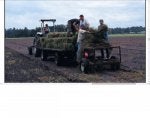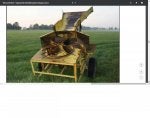Try this...
http://georgiaforages.caes.uga.edu/questions/CSS-FS053.pdf
That should get you started. There's a similar version put out by the TX Ag Extension agency as well... A Google search should turn it up.
Personally if I didn't have a sprigger and couldn't get one at auction, I'd go with the manure spreader option. It doesn't have to be a very good manure spreader, merely functional. Basically any old junk spreader pulled out of the fence row that could be gotten working (the floor chains to move and the spreader flails to spin) would suffice... the floor doesn't even need to be in very good shape, as the bermuda tops will ride on the chains to the beater. The beater will then fluff and pull the tops and sling them out the back onto the ground as you go. You can get cut tops from the bermuda grass stand you already have; you don't even have to buy tops. Just take a bush-hog shredder and chop the stuff up, rake it up, and either using a front end loader with "forks" added onto the bucket (basically the guy I bought my tops from used a bucket that he'd bolted sharpened 2x4's about 4-6 inches apart all the way across the bucket width, sticking straight out the front-- he'd drive along with these sharpened 2x4's skimming the ground, and the tops would push themselves up onto the boards as he drove forward. Now, granted, he used a hay mower, which I would NOT recommend-- you'll get longer runners and more "live runners" (more joints per runner means a higher chance of them "taking root", BUT longer runners are a LOT harder to feed through a sprigger or manure spreader without wrapping and creating a big mess-- I learned that from experience!) A bush-hog will chop the stems up a little more and make it easier to feed through a sprigger or manure spreader. If you don't have a "buck rake" (spikes on a front end loader bucket) you could always just square bale the cut tops IMMEDIATELY after cutting (no drying, or as little as possible) and then it doesn't really matter-- use the hay cutter if you want, because the small square baler plunger knife will cut the runners into manageable "flakes" as the hay is baled. Lacking that, a good old fashioned pitchfork can be used to load freshly cut tops into a manure spreader or onto a trailer for hand spreading (with pitchfork or literally by hand) or however you want to do it...
Hiring sprigging done is like taking $300 bucks an acre to Vegas... it may work, it may not. A lot of it is luck and the weather. From my experience, hiring sprigging is pretty much like hiring any other custom farm work-- the guy wants a fortune, wants to show up on HIS schedule (whether it's a good time to sprig or NOT (USUALLY NOT!) and then they want everything to do it RIGHT THEN and any delays or holdups and they're whining and crying and raising h3ll... and of course "NO GUARANTEES" and you're out a fortune regardless of whether it works or not... I've seen guys around here be "on the schedule" for sprigging, and the guy they hired keeps them waiting for months and then shows up when it's powder-keg dry and hotter than h3ll with little or NO prospect of rain (which is almost essential to success of sprigging bermudagrass) and do the job, collect the big money, and then it's a COMPLETE roll of the dice if it will actually work or not... if it doesn't, they're not out a thing-- in fact they'll be ready and waiting to come back AGAIN when it fails and collect MORE money from you! That's why I hunted around til I found an old one row sprigger (made to run off the belt pulley attachment on an 8N Ford tractor on the 3 point hitch, but I adapted it to a lawnmower motor and put it on my 5610 Ford).
While I'm thinking about it, I'll tell you about an experiment a friend of my Dad's did a long time ago before he died. He was planning to eventually put his entire place into bermuda, and he was building up a 'nursery plot' behind the house to grow his sprigs and tops in... basically a garden-size plot that he could harvest the planting stock from. He had made a "plugger" out of an old post-hole digger or something-- basically it looked like a pogo-stick with a T-handle at the top, and a slightly tapered round cutting edge on the bottom, which would cut out about a 3-4 inch diameter hockey-puck like "plug" of soil, roots, and stems when the foot peg was stepped on (like a shovel) to push the round cutting blade into the ground about an inch or so deep. When the thing was lifted up, more often than not, the "plug" of soil, ROOTS, and stems came up with it... He had rigged a little hand-operated lever that worked a rod and plunger that then pushed the plug out of the cutting blade once it was pulled out of the hole. Basically he could cut out dozens of these plugs like a biscuit cutter cutting out biscuits (or a cookie cutter cutting cookies out of a sheet of dough) and then pick these "plugs" up by hand (or have someone picking them up as he cut them) and then he could simply walk or ride around on freshly-worked ground spreading these plugs onto the soil by hand... then they could easily be rolled down (firmed into the soil) by driving a tractor tire or whatever over them, or with a roller or cultipacker. He even had plans to build a "plug cutter machine" that would consist of a piece of fairly-large diameter heavy wall steel pipe (say about 12-24 inches in diameter) onto which rows of "plug cutters" would be welded (basically say 2-4 inch steel pipe pieces, about 2-3 inches long, preferably tapered (maybe make 4 torch cuts in a "+" pattern and then hammer the pipe in on the cuts, closing them up, and welding them back solid, to make a SLIGHT taper to the pipe). These plug cutters would then have their edges sharpened with a grinder to make them sharp enough to cut through the tops, stems, soil, and roots to cut the plug. The wall of the larger pipe that these cutters were welded to would be cut out inside the cutters once they were welded on, so that the cutters could dump their contents into the center of the pipe through the holes. As the pipe "roller" was pulled over the ground, the round "cookie cutters" would be pushed into the ground by the weight of the roller pipe to which they were welded, which would then cut out the plugs. The plugs would be pulled up out of the ground as the pipe rolled forward (some inevitably would pull back out of the cutter and stay put, but enough would be cut for the process to work) and would "stick" in the cutters. As the pipe turned, either the plug would fall down the hole into the center of the drum roller, or if it remained stuck in the cutter, the next time the cutter was pressed against the ground, the next cut plug would force the previous one up through the hole and into the center of the drum roller. To keep the cut plugs moving out of the center roller drum, it would have auger flighting welded to the inside of the drum, so that as the drum turned, the plugs sliding around inside it would gradually be shoved to one end, where they would be collected by an elevator (old potato chain or old paddle grain elevator chain from a combine or a collection wheel or a conveyor belt or whatever) that would then elevate the cut plugs up into a hopper. These cut plugs could then immediately be spread or slung by hand, or mechanically by means of a spinner (like the tops bale flake spinner) or something of that sort onto freshly worked ground and then immediately rolled in to firm the soil up around them to maintain the moisture to them. The plugs would have a much higher survival rate, because the roots inside the plug of soil they were growing in would remain INTACT in their own little 'capsule' of soil, with the entire thing merely transplanted into a different area of the field and on a wider scale. The moisture in the plug would help sustain the roots and cut stems until rain arrived (still sooner the better, but better than relying on bare root stock (sprigs) or cut tops relying on joints in close contact with moist soil putting out new roots) and even plugs that were planted "upside down" would have a pretty good chance of surviving, because the joints on the stems that were pressed down into the soil (crowns) would then root out and send out a new shoot out the bottom of the plug or round the edge of the plug once the roots took hold. He had started with his "nursery plot" by hand but had expanded it considerably using the hand plugger I mentioned... he planned to eventually "sprig" his entire farm using the "plug method" and then go commercial, but an ugly divorce and failing health put an end to that before he got started...
Anyway, there's more than one way to skin a cat... best of luck!
OL J R







